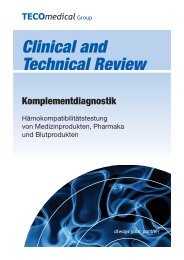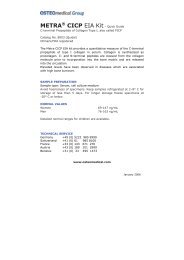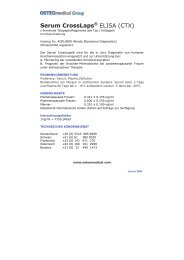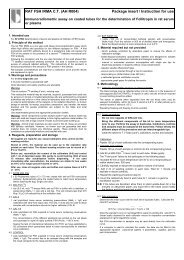Page 1 E N G LIS H D E U T S C H ITA LIA N O F R A N Ç A IS E S P ...
Page 1 E N G LIS H D E U T S C H ITA LIA N O F R A N Ç A IS E S P ...
Page 1 E N G LIS H D E U T S C H ITA LIA N O F R A N Ç A IS E S P ...
You also want an ePaper? Increase the reach of your titles
YUMPU automatically turns print PDFs into web optimized ePapers that Google loves.
The mean (± 1SD) BAP concentration in CTL subjects decreased modestly from baseline to -5.4% (± 19.1%) at 12 months<br />
(p=0.00004) which may reflect the limited bone-sparing effect of calcium. 13<br />
Mean BAP concentrations in ALN subjects decreased 30.5 ± 24.6% at 3 months, 42.8 ± 17.3% at 6 months, and 42.2 ± 19.2% at<br />
12 months. Subjects in ALN were more likely than CTL subjects to demonstrate BAP losses exceeding minimum percent change 14<br />
with 68.5%, 83.9%, and 86.1% of ALN and 9.5%, 15.9% and 9.0% of CTL individuals decreasing by ≥ 25% at the 3, 6, and 12<br />
month timepoints. Distributions of the percent change from baseline in BAP values following 12 months in the ALN or CTL groups<br />
are depicted in the following figure.<br />
Proportion of Population (%)<br />
30.0%<br />
25.0%<br />
20.0%<br />
15.0%<br />
10.0%<br />
5.0%<br />
0.0%<br />
Distribution of Percent Change in BAP Levels Following 12 Months<br />
Therapy with Alendronate (ALN) or Calcium (CTL)<br />
< -70.0%<br />
-70.0 to -60.1%<br />
At 12 months, subjects in ALN had gained LSBMD compared to CTL (p < 0.00001) as shown in the following table.<br />
Changes in LSBMD (Mean ± SD)<br />
-60.0 to -50.1%<br />
-50.0 to -40.1%<br />
-40.0 to -30.1%<br />
n Baseline (g/cm 2 ) 12 months (g/cm 2 ) ∆ (%)<br />
CTL 159 0.75 ± 0.09 0.74 ± 0.09 -0.6 ± 3.4<br />
ALN 121 0.74 ± 0.10 0.79 ± 0.10 5.5 ± 4.1<br />
These results indicate that the Metra BAP assay is safe and effective for monitoring the antiresorptive effect of aminobisphosphonate<br />
(alendronate) therapy among subjects diagnosed with osteoporosis.<br />
Use of Metra BAP for Monitoring Hormonal Antiresorptive Therapy and Predicting Skeletal Response<br />
(Bone Mineral Density) in Postmenopausal Women.<br />
Monitoring Therapy:<br />
A multicenter, randomized controlled trial was successfully conducted to establish the safety and efficacy of the Metra BAP assay<br />
to monitor the changes in serum BAP concentrations associated with estrogen/progestin antiresorptive therapy. Increased bone<br />
turnover and significant loss of bone are often associated with postmenopausal estrogen deficiency. Estrogen replacement has<br />
been shown to effectively decrease bone turnover and protect existing bone mass. 3,6 Subjects were postmenopausal women,<br />
aged 45 to 64 years (mean 56 ± 4 years), who had undergone natural or surgical menopause within the last 10 years. At baseline,<br />
eligible subjects were randomized to either an active treatment group (HRT): Premarin® (0.625 mg daily) with placebo progestin,<br />
Premarin® (0.625 mg daily) and an active progestin (Provera® 2.5 mg/day continuous, Provera® 10 mg/day cyclical, or micronized<br />
progesterone 200 mg/day cyclical); or to the control group (CTL): placebo estrogen and placebo progestin. Serum specimens were<br />
obtained at baseline and 12 months from all subjects.<br />
Mean (± 1SD) baseline BAP concentration (20.7 ± 7.6 vs. 20.3 ± 6.8 U/L, p = 0.704) and LSBMD (0.97 ± 0.17 vs. 0.97 ± 0.15 g/cm 2 ,<br />
p = 0.970) were similar for CTL and HRT. Distributions of baseline BAP values in HRT and CTL are depicted in the following figure by<br />
proportion of the study population.<br />
-30.0 to -20.1%<br />
-20.0 to -10.1%<br />
-10.0 to -0.1%<br />
0.0 to 9.9%<br />
12 Month CTL<br />
12 Month ALN<br />
Decreasing bone turnover % Change<br />
Increasing bone turnover<br />
10.0 to 19.9%<br />
≥ 20.0%<br />
7<br />
ENG<strong>L<strong>IS</strong></strong>H









![PTH [Hormone Parathyroïdienne] Intacte ELISA](https://img.yumpu.com/1233682/1/190x245/pth-hormone-parathyroidienne-intacte-elisa.jpg?quality=85)






